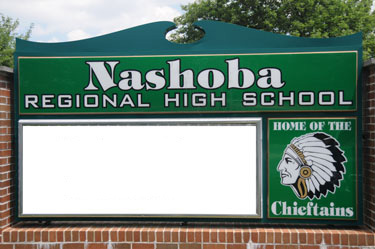
The Nashoba School Committee continued to work on handling a controversial situation for the district at its meeting last night. In other business, both Nashoba and Stow had good news to report regarding academic achievements.
According to Committee Chair Nancy Federspiel of Bolton, the School Committee’s Policy Subcommittee held a special meeting last week to draft a policy addressing the identification and management of students falling under the category of having “a substantial detrimental effect on staff and other students.”
The Subcommittee began deliberating on the need for this policy when some parents of Nashoba Regional High School students voiced concerns over several students who have been allowed to attend classes this year after being arrested over the summer. The charges included weapons possession, kidnapping and assault.
However, Federspiel explained that, before the special Subcommittee meeting, “We found out through the district’s counsel that we could not come up with a definition [for substantial detrimental effect], and that it was actually in the hands of the superintendent.”
One option the Subcommittee has proposed is to add language to the handbook and administration advisory on how to protect students and faculty from a student accused of a crime, said Federspiel. This may state that the student could be subject to regular searches when entering NRHS in the morning, or face random searches of their property during the day. Wood said he is waiting for advice from district counsel on this potential route before making any further moves.
The next Policy Subcommittee meeting is scheduled for Tuesday, November 13.
While the district ponders safety issues, NRHS can still boast a high-performing student body. NRHS Director of Guidance Jodi Specht presented the updated academic profile of the school, showing academic measurements from the SATs and MCAS exams remain well above both the state and national averages.
For example, 61% of the class of 2012 took at least one Advanced Placement class — which offers college-level work — and received at least a 3 on the corresponding AP test. (The highest grade is a 5, and 3 is considered passing.) By comparison, the national average for meeting both AP class participation and grading standards is less than 19%, Specht reported. Approximately 98% of Nashoba graduates head to higher education, she added.
The complete profile — which is included with any transcripts sent for students to potential colleges — is posted on the District’s website.
Wood Heads North
Michael Wood offered some observations from his recent trip to Finland and Sweden to study those countries’ educational systems. With the accent on Finland — which has become renowned for students scoring at the very top of many global tests — Wood explained that the tour brought educators, legislators, and business leaders to classrooms from pre-school through college.
“One of the things we were all looking for is whether Finland has the answer, but the classes look and feel a lot like Nashoba schools,” Wood remarked.
Wood pointed to two big distinctions between Finnish and American schools. “Probably the most pervasive element that came through is everyone really values education. Kids know it is the only way to get a good job, and they talk about it. They are very purposeful,” he said. This cultural accent on education also means teaching is a highly regarded career path, he added.
Another hallmark of the Finnish system is its free, government-subsidized pre-school for ages 1 through 6, he said. And, in both Finland and Sweden, he commented, “There is very little in-fighting about public policy on education, given how valued it is.”
Wood said he wants to learn more about what elements of Finland’s early childhood education programs could help the district’s pre-kindergarten students. And, as a long-time advocate of building the district’s foreign language offering, Wood offered, “We don’t need to have more foreign languages as much as we need to teach foreign culture.” Wood said he is interested in perhaps incorporating lessons into the Social Studies curriculum on how other cultures and their values contrast with those of the U.S.
The trip was paid for out of the superintendent’s professional development budget, Wood said.
Back home, Stow can boast educational successes of its own, with Wood announcing the names of this year’s National Merit Semifinalists — each with a tie to Stow. Residents Madeline Jenkins, Connie Jiang, Samuel Kirschbaum, Joel Sharin, and Steve Tang all qualified to move onto the finals for national scholarships, along with Hale Middle School graduate Sorin Vatasoiu of Marlboro.
In School Committee votes, the Committee voted unanimously to accept $3,000 in donations raised by the Nashoba Athletics Booster Club. Of this, $1,000 will be channeled toward the electronic scoreboard by the new athletic field, while the rest will help fund an upgrade of the public address system and new speakers for the field.
The Committee also voted unanimously to send a letter to the Massachusetts School Building Authority, formally resigning from accepting state funding for the proposed NRHS Science lab renovation. Wood stressed that the state, as promised, will pay about 47% of the design and feasibility study costs already incurred, estimated at up to $320,000.